#new age mythology
Note
If Starseeds are nazis, then how come the lemurians don't feed into the conspiracy theory? I get it that the Nordics and Reptilians are bad, but I've never seen Lemurians, Avians, or Grey aliens feed into harmful stereotypes.
So, a thing about starseed mythology is that a lot of the alien races are basically your Planet of Hats type aliens, where there's no real internal cultural or ideological diversity to speak of. And this does, in fact, all embody a very pernicious cultural stereotype: that cultures outside of your own lack internal diversity and nuance, and that they have nothing that requires any long-term, in-depth study to understand.
This mirrors how New Agers often view actual human cultures, where they just assume that they can understand everything they need to know about them in a very short amount of time, and that they can get them all to convert to New Age spirituality without disrupting their culture. This is an attitude they've inherited from white Christian missionary culture, which has always been a tool of white colonialism.
So whether or not you can immediately pick out an obvious specific racist stereotype on any specific starseed type, they do in fact all feed into a very harmful stereotype.
Also, it does depend on which New Agers you're asking, but grays have very much been implicated in the blood libel stuff and the alien hybrid engineering stuff (which is just great replacement theory with aliens), so yeah.
30 notes
·
View notes
Text
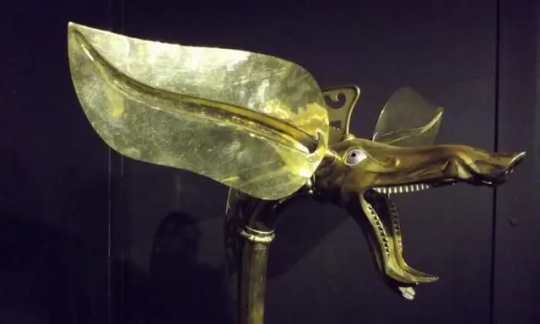

The 'Carnyx' Nightmare of the Roman Soldiers
The Carnyx was a brass musical instrument used as a psychological weapon of war by the ancient Celts between 300 BC and 200AD in western and central Europe and beyond.
The carnyx was once widespread throughout much of Europe, although only a dozen or so fragments are known to us.
It was carried by bands of Celtic mercenaries; it was present at the attack on the Greek sanctuary at Delphi in 279 BC; it defied Julius Caesar in Gaul; and it faced Claudius when he invaded Britain. They are even shown on a Buddhist sculpture in India, proof of the far-flung connections of the Iron Age world.
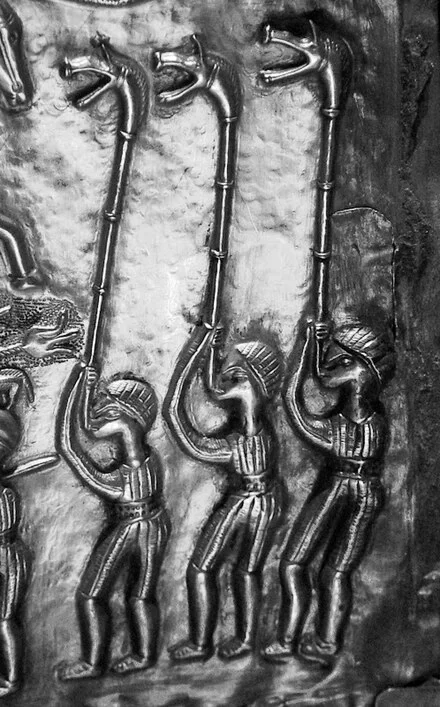
However, they were not only used by the Celts; they were also used by the Dacians in modern Romania. The term “Celtic” is a complicated one. The concept of a pan-European Celtic culture is a myth; rather, aspects of art and technology were shared across vast distances by diverse cultures. The carnyx was one example of this.
A 12-foot-long, thin bronze tube with right-angle bends on both ends made up the carnyx. The lower end ended in a mouthpiece, and the upper end flared out into a bell that was usually decorated to look like a wild boar’s had. Historians believe it had a tongue that flapped up and down, increasing the noise made by the instrument. The carnyx was played upright so that the boar’s head bell protruded well above the warriors’ heads. Its primary goal was to create more noise and confusion on the battlefield.
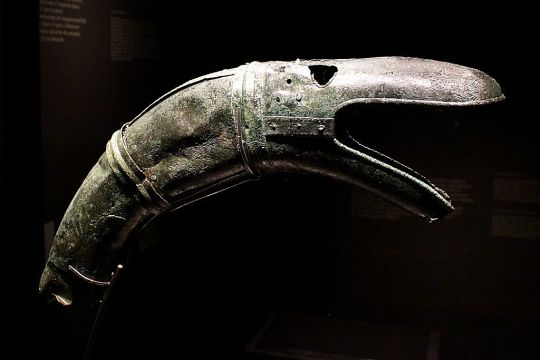
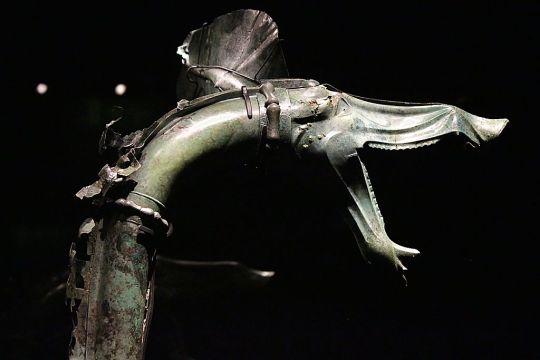

The Greek historian Polybius (206-126BC) was so impressed by the clamor of the Gallic army and the sound of the carnyx, he observed that “there were countless trumpeters and horn blowers and since the whole army was shouting its war cries at the same time there was such a confused sound that the noise seemed to come not only from the trumpeters and the soldiers but also from the countryside which was joining in the echo”.
And the Roman historian Diodorus Siculus wrote, “Their trumpets are also of a peculiar and barbaric kind which produce a harsh, reverberating sound suitable to the confusion of battle.”
Archaeologists discovered a hoard of ritually destroyed weapons in 2004, including a dozen swords, scabbards, spearheads, a shield, bronze helmets, an iron helmet shaped like a swan, a cauldron, animal remains, and seven carnyces. Before the Tintignac discovery, the remains of only five actual carnyces had been found.
The finest was unearthed in Deskford, Scotland in 1816. The Deskford carnyx only has the boar’s head bell and is missing the mane, tongue, and tubing. Images of Carnyx players have been found as well. A Roman denarius, dating from 48 BC bears a representation of a Carnyx. Three carnyx players are featured prominently on the Gundestrup Cauldron, which was found in a Danish peat bog.
One of the seven found at Tintignac, on the other hand, was almost entirely complete. The Tintignac Carnyx was broken into 40 pieces. When puzzled back together, it was found to be just an inch short of six feet long with a single missing section of the tube. The bell was a boar’s head with protruding tusks and large pointed ears. Once restored, the Tintignac Carnyx proved to be the first virtually complete carnyx ever found.
By Leman Altuntaş.
Music video by John Kenny.
#The Carnyx#The 'Carnyx' Nightmare of the Roman Soldiers#Iron Age war trumpet#ancient artifacts#archeology#archeolgst#history#history news#ancient culture#ancient civilizations#celtic mythology#celtic history#roman history#roman empire#roman legion
3K notes
·
View notes
Text
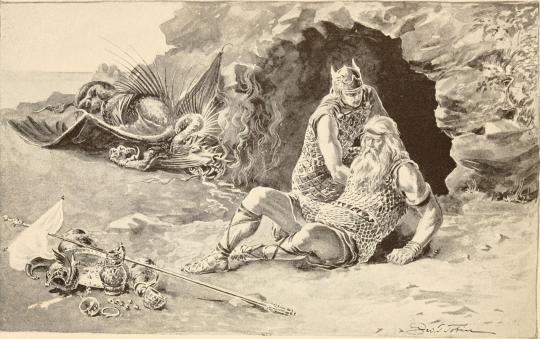
The dying Beowulf, having just defeated the dragon, is supported by his ally Wiglaf. Illustration by George T. Tobin from Siegfried, the Hero of the North, and Beowulf, the Hero of the Anglo-Saxons by Zenaide A. Ragozin, published in 1909. Now in the New York Public Library.
#art#art history#George T. Tobin#illustration#Beowulf#Germanic mythology#Old English#Old English literature#Middle Ages#medieval#medieval literature#American art#20th century art#New York Public Library
205 notes
·
View notes
Text

continuing with the New Age Inc greek god designs, next up’s Athena 🦉🛡️
#lirondelle’s ocs#new age inc#new age inc comic#украрт#artist on tumblr#artists on tumblr#drawing#oc#art#digital art#корпорація нью ейдж#кне#modern greek mythology#greek gods#original characters#character design#original character#ocs#oc design#украртпідтримка#укртумбочка#укртамблер
52 notes
·
View notes
Text

INTRODUCING THE DYNAMIC DUO, THE ICE SPINNER AND THE ORPHAN MAKER!
multimuse featuring more muses from critical role, epic the musical, greek mythology, baldur's gate 3, dragon age, and arcane! performed by henri.
#* self promo.#new promo bc i wasn't satisfied with the other even tho i like the gif-ness of it#also i just. love these two#critical role rp#baldur's gate rp#greek myth rp#greek mythology rp#dragon age rp#epic the musical rp#arcane rp#puts myself in the tags again#sticking my leg up real high
16 notes
·
View notes
Note
I’m a Jew who is interested in learning more about Jewish folklore and Jewish folk practices, as I am super interested in Jewish spirituality and mysticism but am not at a point in my life where it would be appropriate to do anything with Kabbalah. Does anyone have any good resources for that? I’ve been trying to avoid sources that are basically Jewish things repackaged as new-age/pagan.
(In case it’s relevant for FOR, I am Ashkenazi)
.
#jumblr#ask jumblr#judaism#jewblr#jewish#jewish folklore#jewish mysticism#jewish mythology#kabbalah#is this jewish#anti pagan#anti new age
24 notes
·
View notes
Text
i’m sure people smarter than me have said this, but the odyssey is the sequel to the monomyth actually. in the hero’s journey the hero departs from home, from innocence, from safety, to fulfil his destiny. in homer’s the odyssey, the war is over, the destiny fulfilled. next comes the real fight, the unwinnable fight—to return to everything you left home to fight for.
in the first half of the poem, while odysseus fights tooth and nail to return home, his home fights with its last breath to give odysseus a home to return to. and time is running out. his wife penelope is down to her last desperate excuse. suitors have invaded his home, eating through his household and his wealth. his son, telemachus, almost grown, leaves home for the first time to find out if odysseus is still alive, if there is still a reason to keep fighting. having lost everything he had, over and over, odysseus is finally allowed to arrive in his homeland. at first he doesn’t recognise it. and he is cursed to look old and decrepit, so that none of his loved ones would recognise him.
for the second half of the poem, he has returned and miraculously, he has not been displaced or forgotten. but now he has to reclaim what was his. and removing the rot, restoring this place to the home odysseus remembers, is long and painful. instead of walking through the front door, he must sneak in through the back or risk being thrown out. not a single person knows him by sight; odysseus must prove his identity over and over, to every member of his household. he must retell story after story, share secret after secret, reveal every marking or scar upon his body, to finally be recognised by his own family. and then he destroys every last trace of the intruders—kills the men, kills the servants, wipes the slate clean.
by athena’s magic, he is restored to his former youth and glory as he reunites with his wife. the families of the slain suitors try to seek revenge, but zeus, lord of the skies, intervenes. odysseus, filled with his god-given strength, is home, and ready to fight to protect it.
it’s a complete sequel to the heroes journey, but what makes it part of the monomyth is the horrible truth about odysseus’ tale: that it’s impossible. that you will leave, and your home will change in your absence, and someone might fill your place; your family won’t recognise you, your wife met someone else, intruders have destroyed your home, and you will never be as young as you were. you will return and you will fight with every ounce of your strength and it won’t be enough to turn back the clock. it’s the terrible last chapter to every hero’s story that we don’t like to talk about.
and yet, of course, it’s the same story we tell over and over: we’ve won the war, now all we want is to return home, but home is no longer somewhere we can reach.
#the odyssey#hero’s journey#the monomyth#greek mythology#odyssey#homeric hyperfixation haze#sorry this has nothing to do with mxtx but i’ve been sitting on this thought about the odyssey for months#like. i’m sure this isn’t a new thought but.#you think of tolkien and the scourging of the shire#all quiet on the western front#narnia#all the chinese poets#i want to go home. but i am home.#think about how the odyssey ends at the very second athena declared the conflict over.#we don’t see odysseus reaction to it. we see him ready to fight. athena declares a peace.#but it is abrupt. as if athena is slamming the window shut. he won he’s happy that’s enough.#does he manage to live after that? we don’t get to know#i was sitting on this thought for ages. and then i read the greek tragedies. was helping my friend with a paper on home by toni morrison#and yeah this all clicked. got irresistible
167 notes
·
View notes
Text

#really wanna play new age of mythology and ffxvi this month#give me aom demo daaamn#and Enotria tooo aughhhhhhh
10 notes
·
View notes
Note
Fun fact please?
Today You Learned about Shion/Shony.
[Wikipedia’s article is under ‘Seonaidh’, but I read about it under the name ‘Shion’ in Mark Williams’s book.]
So, in the early 1700’s book A Description of the Western Islands of Scotland by Martin Martin (yes, that is his name) describes an annual nighttime ritual on the Isle of Lewis, in the Hebrides, in which the local church community would get together, pick someone to hold a cup of ale, and then wade into the water and dump it in while declaring it an offering to Shion or Shony to have a prosperous harvest. Now Marty-Mart thought that this was a holdover from an old pagan religion. It was popularly believed by scholars that ‘Shion’ must have been some old Celtic deity of the sea, whose cult was long forgotten, but that this one little island off the coast of Scotland remembered, if only for this one little holiday. Wikipedia even calls this ‘likely’, though it doesn’t have a citation for that sentence.
Welp. Probably not, according to Mark Williams.
In his book Ireland’s Immortals, Mark Williams talks about Marty-Mart’s records, and his own research. He also brings up that acclaimed scholar Ronald Hutton (famous debunker of New Age nonsense) independently came to the same conclusion, and that is this: this probably isn’t a pre-Christian ritual that survived. This is probably a pre-Reformation ritual that survived. After all, ‘Seonaidh’ is close to the Scottish Gaelic form of ‘Johnny’, in the same way that ‘Sean’ is the Irish take on ‘John’. Williams suggests that, given there are a ton of weird little festivals for saints all over the world, and the prominence of water, this is probably a ritual feast celebration to Saint John the Baptist, and it somehow survived the Reformation in this remote corner of Scotland.
A bit weird, but I hope it’s a good Fun Fact.
#Fun Fact Friday#Today You Learned#Isle of Lewis#Shion#mythology#Mark Williams#Ronald Hutton#Scotland#Hebrides#Saint John the Baptist#religion#New Age
13 notes
·
View notes
Text
i hope Sköll saved his appetite for the sun today. the Earth has a big plate ready for hims
#just learned that ‘Solulv’ is the Norwegian word for Sun Wolf and it’s literally the word ‘sol’ for sun and ‘ulv’ for wolf squished together#but it’s pronounced ‘soul-oolv’ like the ‘oo’ in the word noodle#i’ve been learning Norwegian for over 600 days so this fascinated me#sköll#skoll#skoll and hati#norse mythology#norse paganism#norse pagan#new age pagan#eclipse#total eclipse#signs of the divine#forgot to mention that the eclipse is in my zodiac sign so i’m especially excited#ragnarok#ragnarök
4 notes
·
View notes
Text
Watching New Age mythology evolve in real time as new societal fears emerge. For a lot of the 20th century and even into the 21st century it was nukes and general environmental destruction that supposedly destroyed a bunch of worlds way back in the past. Now it's suddenly AI that everybody's super confident destroyed all those worlds, and nukes have basically been forgotten.
18 notes
·
View notes
Text

continuing with my designs of greek gods, here’s my take on Dionysus 🍾🐐
#lirondelle’s ocs#new age inc#new age inc comic#украрт#artist on tumblr#artists on tumblr#drawing#oc#art#digital art#корпорація нью ейдж#кне#ocs#greek gods#modern greek mythology#original universe#original characters#original character#original art#character design#Spotify
19 notes
·
View notes
Text
always find it cringe when foreigners meet a scandinavian and go "oh so ur a viking huh?😁" uh no, i sure am not.. the only ones who care about our viking heritage is my old primary school
#remembering when they discovered viking age relics on the school ground and none of us cared??#we were just like ugh whatever bc it postponed the building of a new sports hall lmaoo#but they dedicated weeks for us to learn abt the vikings and held a viking themed festival#the most passionate participant was the mother of a boy from my class whose family believed in norse mythology#she was quite eccentric and had a booth were she weaved. queen honestly
5 notes
·
View notes
Video
undefined
tumblr
Discover the ancient beliefs of Tengrism with Monotheist! Learn about the origins, practices, and significance of Mongolian Tengrism in this concise and easy-to-understand video. Join us as we explore the fascinating world of Tengrism and explore its cultural and spiritual heritage. Subscribe for more insightful content on faith and culture. #Monotheist #TengrismExplained #MongolianBeliefs #SpiritualHeritage #AncientWisdom #CulturalTraditions #DivineConnection #TengriCosmos #shamanicpractices #tangri #turkey #viral #explore #reels #trending #education
#tengrism#tengri#mongols#turks#central asia#Turks#Central Asia#Türken#Steppe Empire#Mongols#Tengrism#Tengrianism#Tengriism#Mongol Mythology#New Age#Ancient Religion#Ancient Religions#Religion#Tree of Life#Lifestream#Sky God#Deities#Gods of the world#Shamanism#monotheist#mongolian#trending#What is Tengrism? | Origin of Tengrism | Mongolian Tengrism Explained#viral#explore
2 notes
·
View notes
Text
Something I think is interesting is like modern mythology and collective storytelling
Like do we offer things to gods on this site? Not often. Do we very vehemently insist that Apollo and his godforsaken dodgeball is real? Yes. Does a large %age of the population know about Arepo and the god of many small joys?
Those kinds of things fill the niche of folklore and I’m fascinated by it
#this along with meme hieroglyphs is just#i wanna study it under a microscope#you see a dancing crab or that one picture of misha in the supernatural finale and you know theres news#this may show the amount of time I’ve been on tumblr but like staff itself has historically almost been a single being#staff not being a collection of people in a company but something eldrich that watch us#idk I just think new age naturally forming mythologies is interesting#tumblr witches missing out
10 notes
·
View notes
Video
undefined
tumblr

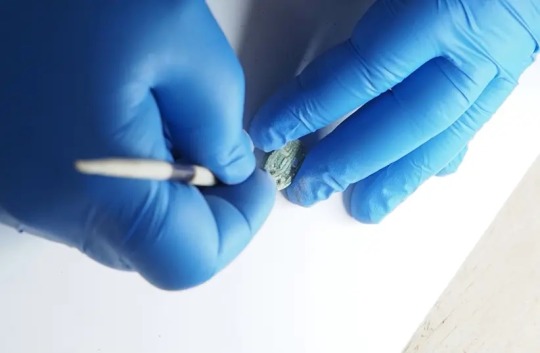
A 3,000-Year-Old Egyptian Amulet Discovered on Field Trip in Israel
The group's leader calls the find 'the dream of every amateur archaeologist.'
Students on a field trip hosted by the Israel Antiquities Authority (IAA) in Azor, five miles southeast of Tel Aviv, witnessed archaeology in action when the group’s leader Gilad Stern happened upon a 3,000-year-old amulet.
Stern was guiding eighth grade students on the IAA’s third annual expedition, educating them about archaeological finds around Azor and beyond, when he saw what first looked like a lost toy on the ground. “An inner voice said to me, ‘Pick it up and turn it over,’” Stern told the Jerusalem Post. “I was astonished: it was a scarab with a clearly incised scene, the dream of every amateur archaeologist. The pupils were really excited!”
The amulet is sculpted in the shape of a dung beetle, an insect regarded throughout ancient cultures as an all-powerful creator god for embodying both decay and regeneration, as it incubates its eggs in the waste of other animals. The amulet’s flat face features two figures: one with an elongated head, evocative of the Egyptian pharaoh’s crown, who appears to bestow power on the other slightly bowed figure.
Based on the scene, Amir Golani, a senior research archaeologist at the IAA, has dated the amulet to the late Bronze Age (1,500–1,000 B.C.E.), “when the local Canaanite rulers lived (and sometimes rebelled) under Egyptian political and cultural hegemony.” Golani reckons this seal of power either fell from the hands of an important official passing through, or was buried on purpose. “It’s difficult to determine the exact original context,” he said.
“It may have been placed on a necklace or a ring [and] is made of faience, a silicate material coated with a bluish-green glaze,” Golani added, noting these Egyptian relics abound across Israel—though not every scarab was actually made in Egypt. The IAA said the caliber of workmanship on this example was “not typical for Egypt and may represent a product of local craftsmen” emulating the popular Egyptian aesthetic, according to Times of Israel.
“The find of the scarab, in the framework of a field tour with pupils participating in the tour-guide course, is symbolic in that the pupils were gaining archaeological knowledge and at the same time contributing to our archaeological heritage,” IAA director Eli Escusido remarked. “This cooperation is truly moving, as we are working toward connecting communities with their cultural heritage.”
By Vittoria Benzine.
#A 3000-Year-Old Egyptian Amulet Discovered on Field Trip in Israel#scarab#jewelry#ancient jewelry#ancient artifacts#history#history news#ancient history#ancient culture#ancient civilizations#bronze age#egyptian history#egyptian mythology
36 notes
·
View notes